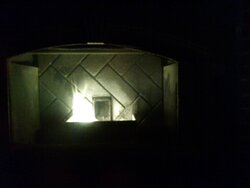My intake is using room air and if I put my hand over it should I feel suction?
No you will not feel suction. You might wet the back of your hand, put it by the draft slide and feel draft. Best bet is to take a cigarette and put it by the draft and see if the smoke is getting sucked in.
Outside air kit is only required in mobile homes and in newer construction where the house is tightly insulated. That's such a subjective recommendation that it's almost useless. My house, built in 1955 is drafty, I have the OAK after burning the first year without it. While not absolutely needed to use the stove I would suggest to anyone to install it. Much more automated control of the stove. I don't even use the manual draft except when starting the stove and that's for only about 20 minutes and then it is shut completely, I even have the screw stop removed so that it closes 100%.
You have the low feed set at 2.4. That seems high for the low end, that stove should give plenty of heat with the low setting at 2pph and the high setting at 5pph. At least try with those setting and work from there.
You need to check the DF settings and make sure they aren't out of whack. 230 low, 270 high to begin with. Best bet is to reset everything to the factory defaults and go from there.
You have a 6041 I have the 6039, it is the same stove except the board is a little different and you have an igniter otherwise they are physically the same.
One question, does your board heat range go from 1 thru 9, or 1 thru 5? I saw some of the first 6041's that had both, kind of strange but I guess they use what's available. Not a big deal other than figuring the fuel feed rates between the high and low settings.
These settings I recommended are for running the stove on AUTO, if running in manual that's a different animal and will take some tweaking, best to start in AUTO and learn the stove, every setting can be adjusted to tune that stove in so that it runs in AUTO no problem.



